The stock market is back in an uptrend. Moreover, the rally is being led by the technology sector, which is usually a very bullish development.
Last week in this space, I noted that money flows into stocks were increasing. So far, that's been a correct observation.
The fact is that markets have short memories, because the algos who do most of the trading are only focused on the next piece of news that hits and the general trend in the flow of buy and sell orders for stocks and options. As a result, once the news flow related to the banking crisis slowed, the algos moved on to the next thing, which was the notion that the Federal Reserve may have stopped raising interest rates.
In a sense, that's a relief, because if humans were in charge, there would still be a good deal of worrying and handwringing going on, especially about what the Fed will do next and the fate of the banking sector. Of course, anyone who's traded the markets before the algos took over knows that sometimes a bit of handwringing and worry-warting can be healthy, especially when it comes to the Fed, especially this incarnation of the central bank, which is woefully untrustworthy.
Arguably, the banking crisis could reignite and the market would be back on the path to decline. So I and perhaps other geezer traders will continue to trade the trend, which is up for now, as we secretly worry about the next disaster that is almost certainly looming. Nevertheless, despite the gloom and doom and increased volatility, money seems to be moving into the stock market. So we don't fight the tape. But we remain cautious, because there are still many negatives that are lurking, especially a resumption of U.S. inflationary data.
Bond Yields Break Below. Mortgage Rates Fall. Housing Stocks Perk Up.
To look at the most recent inflation data, the Fed's favorite gauge, the Personal Consumption Estimate (PCE deflator), came in lighter than expectations, clocking in at a core reading of 0.3% month-to-month rise versus an expected 0.4%. That's a 4.7% annual growth rate, still well above that magic 2% number. The biggest contributors were restaurant and hotel expenses; party on. Somehow, spending fell and personal income rose, although the pace of rise has slowed.
Meanwhile, the University of Michigan's consumer sentiment and expectations indexes fell in response to the banking crisis. Certainly, these are mixed indicators, but they do suggest that there is a rising wall of worry in consumer land.
Yet the U.S. Ten Year Note yield (TNX) is still hovering near 3.5%. This suggests that bond traders are not fully convinced that inflation is dead, while still waiting for the recession to be fully apparent. Unfortunately, this plus-minus data means that the Fed may still raise rates another quarter point at its next meeting, which is scheduled for May 2-3.
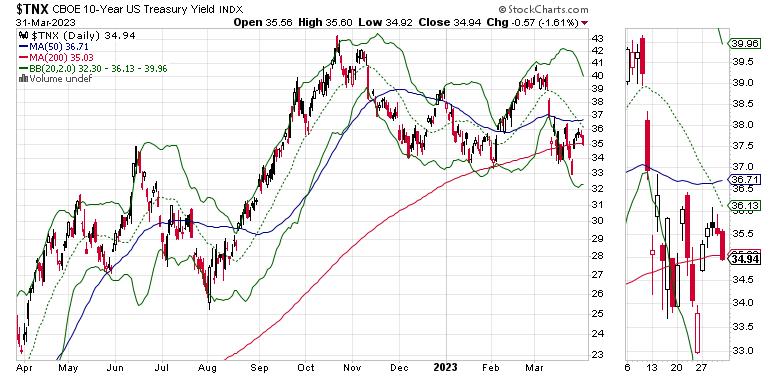
On the plus side, the steady tone in TNX has, as I expected, led to a further decline in mortgage rates. The average 30-year mortgage is now below 6.4%. Moreover, the rate has broken below its 20-day moving average, signaling a short-term reversal, which should translate into a mini-boom in home purchasing activity as potential buyers who have been on the fence finally make their move.
I've seen a pickup in activity in my usual haunts of late. And yes, those out-of-state license plates, California, Illinois, and New Jersey, continue to crowd my freeway travels, which means the Great Migration continues. I've been bullish on the homebuilder sector for the last few years and I continue to recommend homebuilder shares, You can check my picks out with a free trial to my service here.
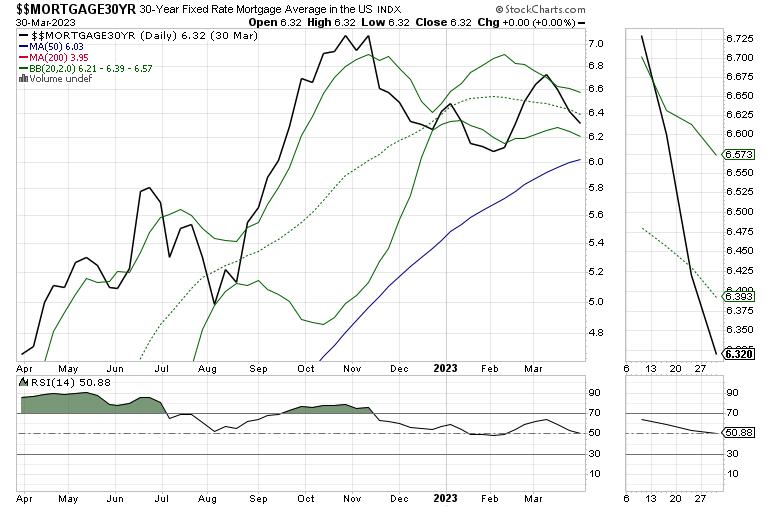
Moreover, the action in homebuilder stocks is starting to heat up once again. The SPDR S&P Homebuilder ETF (XHB) moved back above its 50-day moving average as Accumulation Distribution (ADI) and On Balance Volume have stabilized. The Rate of Change Indicator (ROC) has also turned up. This type of change in ROC often predicts a bullish reversal in both ADI and OBV.
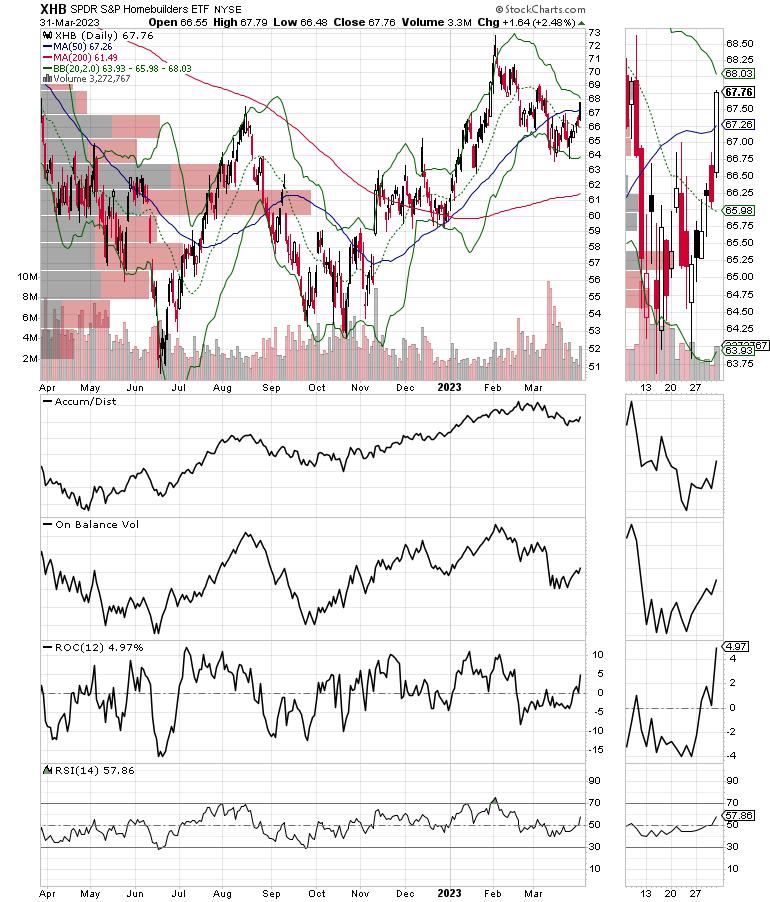
I discussed the long term investment potential in homebuilder stocks in my latest Your Daily Five video, focused on investing in Megatrends. And I've just put the finishing touches on a Special Report titled: "How to Invest in the Housing Megatrend," which is you can download my Buy me a Coffee page.
Summer Heat Approaches; Energy Sector Could be Close to Awakening
With the technology stocks firing on all cylinders, as I suggested they might in this space last week, I'm turning my attention to the biggest wallflower sector in the market, energy -- specifically, the oil market.
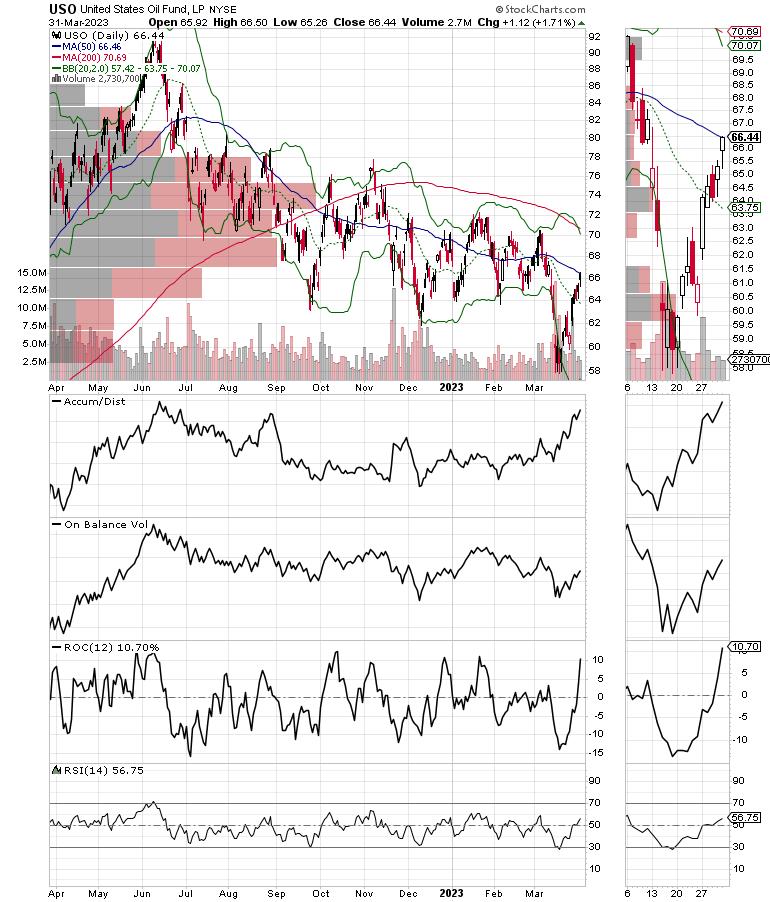
That's because we're getting close to driving season and supplies for gasoline and crude are tight. Meanwhile, the shale oil producers in Texas and to some degree elsewhere in the U.S. are in no hurry to ramp up production. In addition, gasoline supplies are still lagging, even though refineries are ramping up and working at 90% of capacity, which is close to their limit.
Much of the decline in oil has been due to expectations that the U.S. economy is headed for recession. But that line of thinking is ignoring an equally valid reality, that of a supply crunch in crude, gasoline, and the woefully available diesel fuel developing due to some geopolitical event.
Sure, the Ukraine war has now been fully factored into the supply situation. And daily news reports suggest that Russia is selling oil to anyone who wants it, as the Saudis pivot toward China as their new BFF when it comes to purchasing oil.
But that's precisely my point. With shale oil supplies flattening out, and the strategic petroleum supply (SPR) having been drawn down by the White House, there really is no slack for oil in the U.S at the moment. In other words, it's plausible that the U.S. could find itself in a similar situation to where Germany was in relationship to natural gas when the Ukraine war erupted and sanctions were placed on Russia, where prices climbed and shortages were the order of the day. Now that supply has been restored to Germany by the U.S. and other natural gas suppliers, prices remain higher than they would have been if Russia would have continued to supply Germany as it had for decades.
That's why I'm keeping a close eye on the U.S. Oil ETF (USO), which has recently come off its bottom.
I'm focusing on the $67 price area, as this is slightly above the 50-day moving average. A move above the 50-day could be a bullish short to intermediate term development for USO since the Accumulation Distribution (ADI) and On Balance Volume (OBV) indicators are suggesting that money is moving into oil via this ETF in an aggressive fashion.
You can access my recent report on the energy market here.
Bullish Money Flows Continue. Nasdaq Breaks Above 13,000
The market's breadth is back in an uptrend as the New York Stock Exchange Advance Decline line (NYAD) held above its long term support line, the 200-day moving average, and further rallied above its 50-day moving average. These are bullish developments.
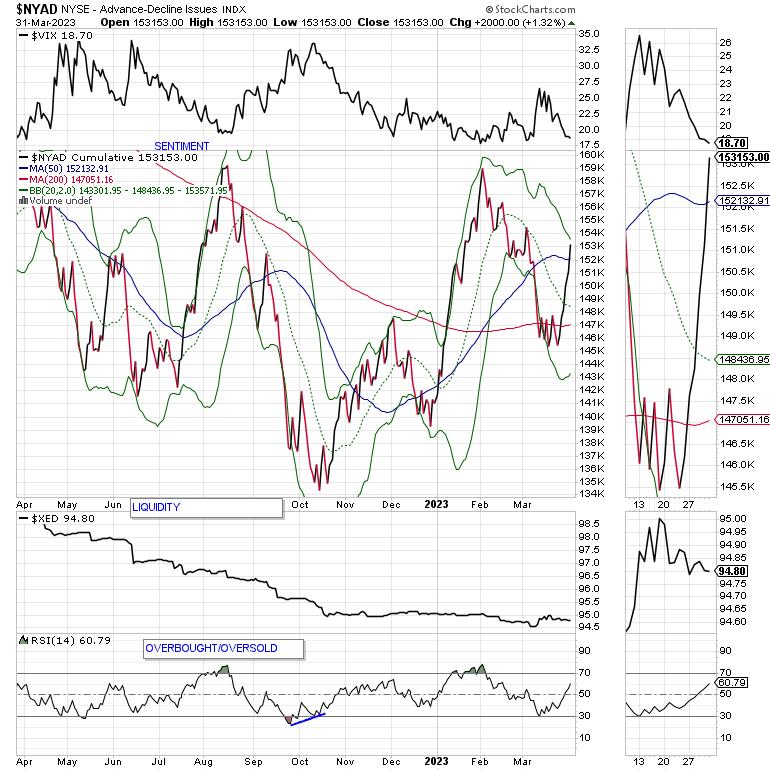
Meanwhile, the S&P 500 (SPX) rallied along with NYAD after also holding at its 200-day moving average. The next challenge for SPX is the resistance area at 4100-4200. The most bullish development, however, is that On Balance Volume (OBV) is starting to move higher while Accumulation Distribution (ADI) is holding steady. Combined these two indicators suggest money is moving into stocks.
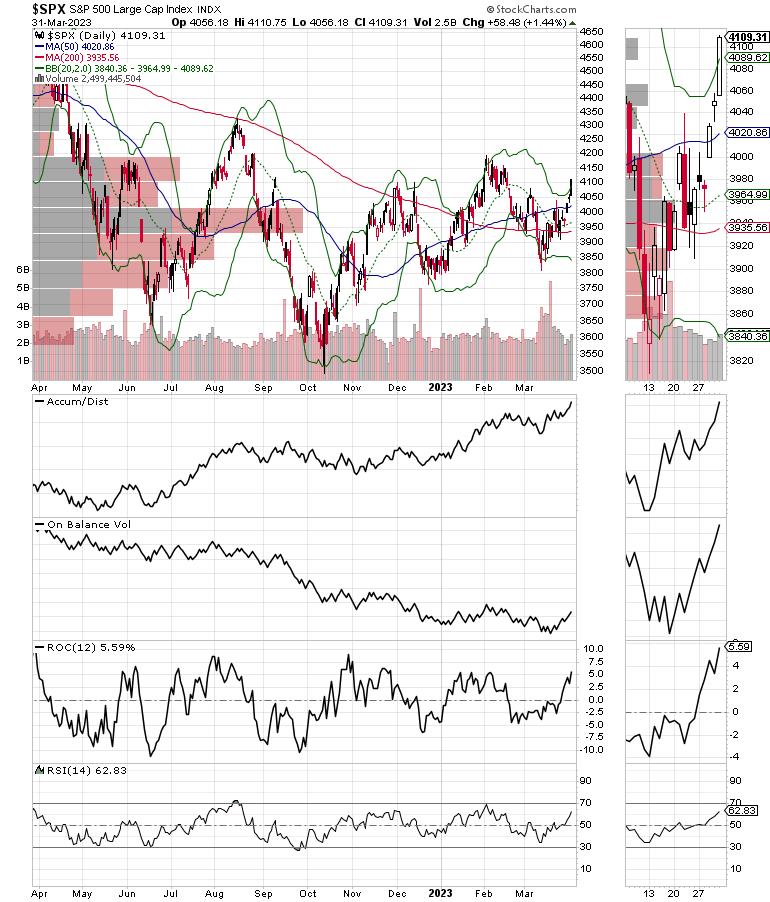
Meanwhile, the Nasdaq 100 Index (NDX) delivered a breakout above 13,000. This is very bullish, as it suggests money is now pouring into technology stocks. When tech stocks rally, the give the whole market a boost. Accumulation Distribution (ADI) and On Balance Volume (OBV) are very bullish for NDX.
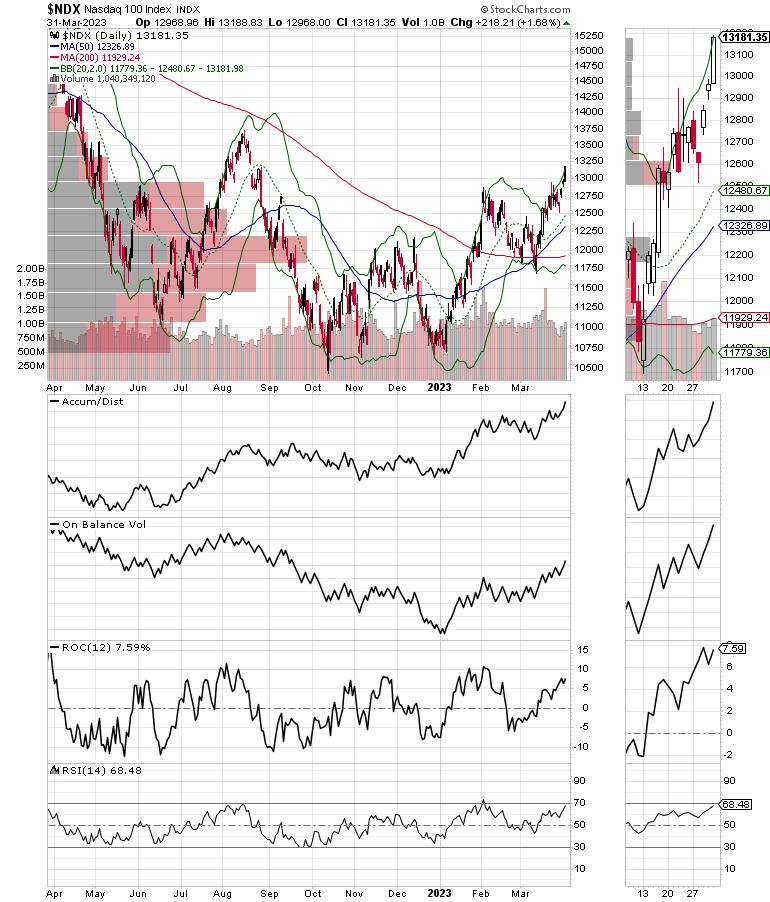
The CBOE Volatility Index (VIX) has broken below 20, a sign that the bears are throwing in the towel.
When VIX rises, stocks tend to fall, as rising put volume is a sign that market makers are selling stock index futures in order to hedge their put sales to the public. A fall in VIX is bullish, as it means less put option buying, and it eventually leads to call buying. This causes market makers to hedge by buying stock index futures and raises the odds of higher stock prices.
The market's liquidity remains stable as the Eurodollar Index (XED) remained above support near 94.75. A move above 95 will be a bullish development for sure. Usually, a stable or rising XED is very bullish for stocks. On the other hand, in the current environment, it's more of a sign that fear is rising and investors are raising cash.
To get the latest up-to-date information on options trading, check out Options Trading for Dummies, now in its 4th Edition—Get Your Copy Now! Now also available in Audible audiobook format!
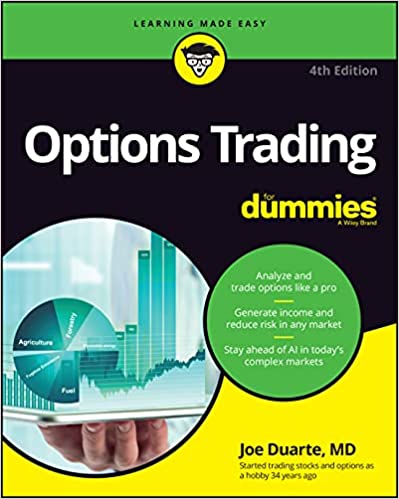 #1 New Release on Options Trading!
#1 New Release on Options Trading!
Good news! I've made my NYAD-Complexity - Chaos chart (featured on my YD5 videos) and a few other favorites public. You can find them here.
Joe Duarte
In The Money Options
Joe Duarte is a former money manager, an active trader, and a widely recognized independent stock market analyst since 1987. He is author of eight investment books, including the best-selling Trading Options for Dummies, rated a TOP Options Book for 2018 by Benzinga.com and now in its third edition, plus The Everything Investing in Your 20s and 30s Book and six other trading books.
The Everything Investing in Your 20s and 30s Book is available at Amazon and Barnes and Noble. It has also been recommended as a Washington Post Color of Money Book of the Month.
To receive Joe's exclusive stock, option and ETF recommendations, in your mailbox every week visit https://joeduarteinthemoneyoptions.com/secure/order_email.asp.
